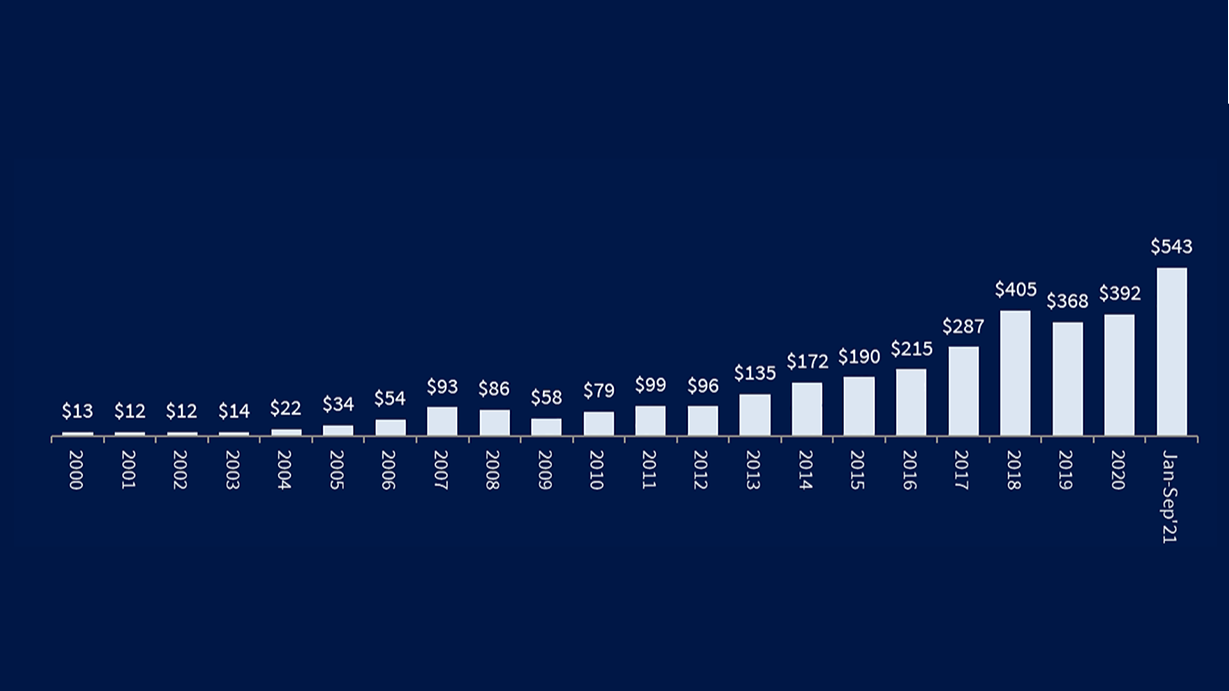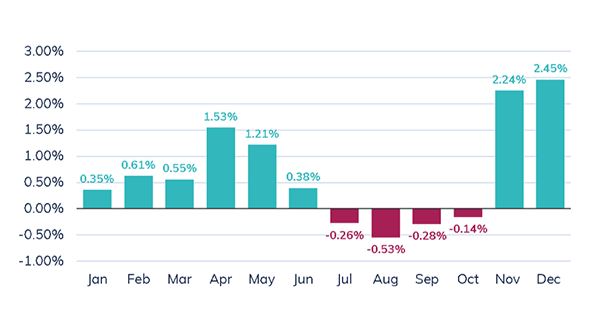Data Analytics and Indices

Trending
Index Insights: September 2024
September 2024 index performance was generally positive for broad-based U.S. indices. The S&P 500 lifted 2% to close at all-time highs of 5,762.48, which is nearly 992 points, or 20.7%, above the 2023 closing level of 4769.83.
Read MoreSeptember 2024 index performance was generally positive for broad-based U.S. indices. The S&P 500 lifted 2% to close at all-time highs of 5,762.48, which is nearly 992 points, or 20.7%, above the 2023 closing level of 4769.83. Small caps underperformed, with the Russell 2000 Index up about eight points, or less than half a percent to close at 2,229.97, putting the index up nearly 10% year-to-date (YTD). Notably, implied volatility was higher this month, with the Cboe Volatility Index® (VIX Index®) lifting from 15 to 16.72 as premiums increased a bit on geopolitical concerns and the looming U.S. election. The slight lift for equities led to gains in both call-write and put-write indices on the S&P 500, Russell 2000, MSCI and fixed income segments, which perform well in sideways markets with relatively muted realized volatility.
Equity Indices
Source: Cboe Global Markets
The Russell 2000 Index (RUT) measures the performance of small-cap segment of the U.S. equity universe. It is a subset of the Russell 3000® Index and includes approximately 2000 securities based on a combination of their market cap and current index membership. RUT options are valuable tools for increasing yields and managing risk. The Cboe S&P 500® Index option contract (SPX), is designed to track the underlying S&P 500 Index and help investors achieve broad market protection. SPX® options offer the potential opportunity to manage large-cap U.S. equity exposure and execute risk management, hedging, asset allocation, and income generation strategies.
Volatility Indices
Source: Cboe Global Markets
The VIX Index is based on real-time prices of options on the S&P 500® Index (SPX) and is designed to reflect investors' consensus view of future (30-day) expected stock market volatility. Cboe 1-Day Volatility Index® (VIX1D Index) estimates expected volatility by aggregating the weighted prices of P.M.-settled S&P 500 Index (SPX) puts and calls over a wide range of strike prices. The Cboe 3-Month Volatility IndexSM (VIX3M) is designed to be a constant measure of 3-month implied volatility of the S&P 500® (SPX) Index options.
Dispersion and Correlation Indices
Source: Cboe Global Markets
The Cboe S&P 500 Dispersion Index (DSPX) measures the expected dispersion in the S&P 500 Index over the next 30 calendar days, as calculated from the prices of S&P 500 Index options and the prices of single stock options of selected S&P 500 Index constituents, using a modified version of the VIX® methodology. The Cboe S&P 500 Implied Correlation Indices including COR1M and COR6M are the first widely disseminated market estimates of the average correlation of the stocks that comprise the S&P 500. The Cboe S&P 500 Implied Correlation Indexes offers insight into the relative cost of SPX options compared to the price of options on individual stocks that comprise the S&P 500.
BuyWrite Indices – Equity
Source: Cboe Global Markets
The Cboe® MSCI Emerging Markets BuyWrite Index (BXEF) is a benchmark index designed to track the performance of a hypothetical buy-write strategy on the MXEF® index. The Cboe S&P 500 BuyWrite Index (BXM) is a benchmark index designed to track the performance of a hypothetical buy-write strategy on the S&P 500 Index®. The Cboe S&P 500 Half BuyWrite Index (BXMH) is a benchmark index designed to track the performance of a hypothetical covered call strategy. The BXMH Index is similar in design to the Cboe S&P 500 BuyWrite Index (BXM). However, the difference in methodology is as follows: the strategy only writes half a unit of an ATM monthly SPX call option while the long SPX Index position remains unchanged. The Cboe Validus S&P 500® Dynamic Call BuyWriteSM Index (CALD) tracks the value of a hypothetical rules-based investment strategy which consists of overlaying a basket of S&P 500 a.m.-settled standard expiry short call options over a long position invested in the S&P 500 with dividends reinvested (total return).
PutWrite Indices
Source: Cboe Global Markets
The Cboe S&P 500 PutWrite Index (PUT) tracks the value of a hypothetical portfolio of securities (PUT portfolio) that yields a buffered exposure to S&P 500 stock returns. The PUT portfolio is composed of one- and three-month Treasury bills and of a short position in at-the-money put options on the S&P 500 index (SPX puts). The number of puts sold is selected to ensure that the value of the portfolio does not become negative when the portfolio is rebalanced. The Cboe Validus S&P 500 Dynamic PutWrite Index (PUTD) is designed to track the value of a rule-based investment strategy which consists of overlaying a basket of S&P 500 (SPX) a.m. settled standard-expiry short put options over a money market account invested at the 4-week daily Treasury Bill rate. The Cboe Russell 2000 PutWrite Index (PUTR) tracks the value of a hypothetical portfolio of securities (PUTR portfolio) that yields a buffered exposure to Russell 2000 Index stock returns. The PUTR portfolio is composed of an investment of $K in one-month Treasury bills and of a short position in an at-the-money puts on the Russell 2000 Index (RUT put), where K is the strike price of the put option.
BuyWrite Indices – Fixed Income
Source: Cboe Global Markets
The Cboe HYG BuyWrite Index (BXHB) is designed to track the performance of a covered call strategy with a short iShares iBoxx $ High Yield Corporate Bond ETF (HYG) call option expiring monthly. The Cboe LQD BuyWrite Index (BXLB) is designed to track the performance of a covered call strategy with a short iShares iBoxx $ Investment Grade Corporate Bond ETF (LQD) Call option expiring monthly. The Cboe TLT 2% OTM BuyWrite Index (BXTB) is designed to track the performance of a covered call strategy with a short iShares 20+ Year Treasury Bond ETF (TLT) Call option expiring monthly.
Target Outcome Series
Source: Cboe Global Markets
The Cboe S&P 500 Enhanced Growth Index Series (SPEN) and Cboe S&P 500 Buffer Protect Index Series (SPRO)are part of a family of Target Outcome Indices. The Indices are designed to provide target outcome returns linked to the U.S. domestic stock market. The indices measure the performance of a portfolio of hypothetical exchange traded Flexible Exchange® Options ("FLEX® Options") that are based on the S&P 500® Index.
Protective Put Indices
Source: Cboe Global Markets
The Cboe VIX Tail Hedge Index (VXTH) tracks the performance of a hypothetical portfolio that:
- Buys and holds the performance of the S&P 500 index (the total return index, with dividends reinvested), and
- Buys one-month 30-delta call options on the Cboe Volatility Index (VIX). New VIX calls are purchased monthly, a procedure known as the "roll." The weight of the VIX calls in the portfolio varies at each roll and depends on the forward value of VIX, an indicator for the perceived probability of a "swan event."
- The weights are determined according to this schedule and the weights applied at a particular roll date can be seen by opening the VXTH Monthly Roll Spreadsheet.
There are important risks associated with transacting in any of the Cboe Company products or any digital assets discussed here. Before engaging in any transactions in those products or digital assets, it is important for market participants to carefully review the disclosures and disclaimers contained at: https://www.cboe.com/us_disclaimers/. These products and digital assets are complex and are suitable only for sophisticated market participants. These products involve the risk of loss, which can be substantial and, depending on the type of product, can exceed the amount of money deposited in establishing the position. Market participants should put at risk only funds that they can afford to lose without affecting their lifestyle. © 2024 Cboe Exchange, Inc. All Rights Reserved.

















































































